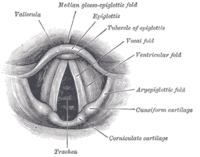
Photo from wikipedia
OBJECTIVE Despite the fact that vocal nodules are the most common cause of chronic dysphonia in children, uncertainty and lack of consensus complicates practically every diagnostic and management decision. Selecting… Click to show full abstract
OBJECTIVE Despite the fact that vocal nodules are the most common cause of chronic dysphonia in children, uncertainty and lack of consensus complicates practically every diagnostic and management decision. Selecting an optimal staging system is fundamental to understanding a disease process, mandatory for uniform reporting, and crucial to predicting natural history and treatment outcomes. The ideal prognostic model for vocal nodules is under intense debate. The purpose of this study was to analyze the predictive power of vocal nodule grade to severity of voice metrics in children. METHODS Seventy-nine patients diagnosed with vocal cord nodules between 2006 and 2012 were drawn from UPMC Children's Hospital of Pittsburgh Voice, Resonance and Swallowing Center Research Registry. Subject age at time of diagnosis, nodule grade, relevant co-morbidities, scores on The Consensus Auditory-Perceptual Evaluation of Voice (CAPE-V), parent-reported Pediatric Voice Handicap Index (pVHI), the phonotraumatic behaviors profile, habitual speaking pitch fundamental frequencies, pitch range, volume intensity, and s/z ratio were recorded and compiled into a de-identified database for analysis. RESULTS Based on the Kruskal-Wallis H Test, there was no statistically significant correlation between nodule grade and total pitch range (p = .21), s/z ratio (p = .50), volume intensity (p = .33), overall CAPE-V Scores (p = .15), or pVHI Scores (p = .29). Chi-squared tests also revealed no significant associations between nodule grade and abnormality in habitual speaking pitch (p = .14 for fundamental frequency while sustaining a vowel sound, p = .37 for fundamental frequency while speaking structured tasks i.e. counting, or p = .76 while speaking in conversation). CONCLUSION The current "gold-standard" for grading vocal nodule size suggests that the nodules themselves are not driving the standard dysphonic metrics that are most commonly collected and monitored in such children. This outcome is consistent with other studies reporting similar findings and was expected based on the inconsistencies in the reported literature to date. By extension, the conventional wisdom of avoiding surgical treatment of vocal nodules in children seems prudent as there is little evidence to suggest that the nodules themselves are "driving" the severity of the dysphonia. Ultimately identifying the true "drivers" of dysphonia in children will suggest alternative therapies that are more specific and directed to the pathophysiology. Most pediatric voice care professionals will welcome such discoveries as those in the front line of patient care are often rendered helpless and frustrated.
Journal Title: International journal of pediatric otorhinolaryngology
Year Published: 2019
Link to full text (if available)
Share on Social Media: Sign Up to like & get
recommendations!